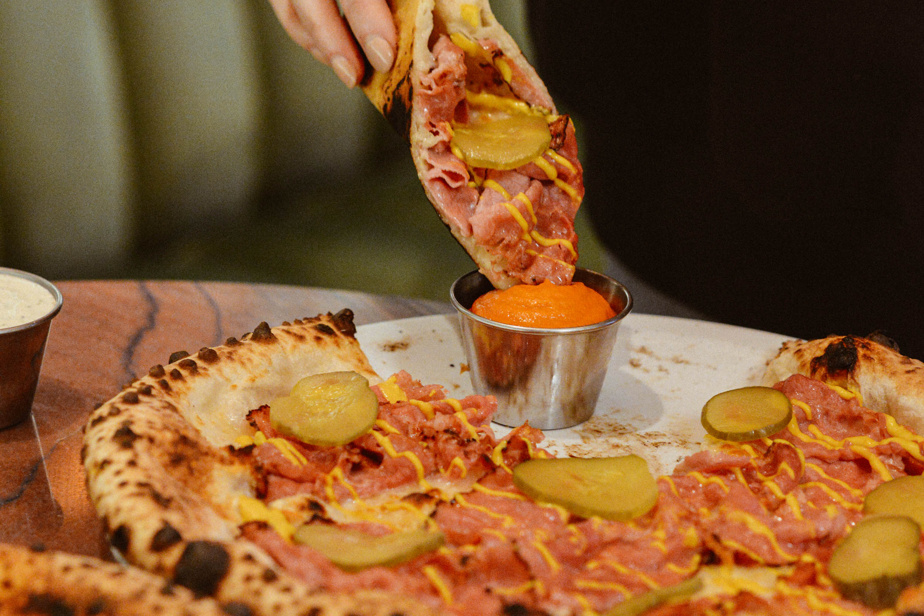“Neapolitan” pizza with smoked meat, cauliflower dish with doenjang and Charlevoix cheese, tacos with boudin, squash and Quebec apple… Welcome to Montreal, where we have “an appetite for the astonishing”!
1er November, more than 200 members of the food industry – chefs, sommeliers, restaurateurs, journalists, researchers and others – gathered at the PHI Center for the All in the Same Plate event, which was in his third year.
Much has been said about the culinary identity of the metropolis, which more than ever has a desire to position itself as the gourmet capital of North America under the leadership of the Office Montréal de la Gastronomie (OMG), created in 2021.
Montreal is a city where you eat really well. There is no longer any doubt about this and our reputation now follows us almost everywhere in the world. But Montreal is also a slightly rebellious city and allergic to labels (and stars!). Attempts to circumscribe the metropolis’ abundant culinary identity generally result more in a list of practices, attitudes and philosophies than in an enumeration of specific dishes.

PHOTO ALAIN ROBERGE, LA PRESSE ARCHIVES
Obviously, smoked meat comes to mind when we talk about Montreal.
Certainly, we have some very concrete emblems like the bagel, smoked meat and Montreal steak spices, among others, but what stands out above all is the diversity, the openness, the creativity, the good atmosphere, the relaxed side and uninhibited by our gastronomy, among other things.
That said, you shouldn’t be afraid of clichés either, says Stéphanie Laurin, director of the OMG.
When we arrive in Lisbon, we have sardines and natas directly in the forehead! Clichés are important as a first level of access to our gastronomy. We must embrace them, even if they obviously do not totally define us.
Stéphanie Laurin, director of the Montreal Gastronomy Office
Montreal, plural city
The OMG has been looking into the question of culinary identity since its creation in 2021. Last year, at this time, Amélie Masson-Labonté, culinary historian and founder of the company Storica, presented us with some preliminary results of ‘a project carried out as part of an agreement between the Société du network des économusées and the OMG. A year later, still on Tous dans la same plate, she revealed the factors and indicators of “Montréality” that emerged from her research and consultations.
“From the second half of the 19th centurye century until the beginning of the 20the, large cities on the East Coast like Montreal, New York and Boston are seeing fairly similar waves of migration: thousands of Irish fleeing famine, Cantonese Chinese looking for work, Jews fleeing pogroms in Eastern Europe. East and Italians, driven out by the unstable climate following the unification of Italy. Culinarily speaking, we are right to wonder what really sets Montreal apart from other large cities in North America. Its French character certainly, but also the way in which Jewish, Chinese or Italian culinary cultures for example begin to hybridize over time, with each other and with local specialties. »
Montreal is therefore a city that is both French-speaking and plural, it is a festive, working-class and popular city, innovative, gourmet and creative. It is not for nothing that the new signature proposed by the OMG, developed with the firm LG2, is “Montréal, an appetite for the astonishing”.
During the year, the inspired and dynamic strategist Lily Barrière Groppi (LG2) led workshops with a large number of players in the field (including the author of these lines) to arrive at this positioning which serves above all to develop a common vocabulary around our uniqueness.

PHOTO DOMINICK GRAVEL, LA PRESSE ARCHIVES
These popular dumplings from the 9 Tail Fox restaurant, rue Notre-Dame Ouest, stuffed with mushrooms and parmesan, bathed in a Korean yuja sauce.
Finally, Montrealers are beginning to understand to what extent the explosion of their food traditions is an opportunity rather than a lack. It allows self-expression above all. In our country, no culinary heresy is possible (except that of being bland!), which is not the case in many other cultures. Talk to Tommaso Melilli, a young chef of “new Italian cuisine” who has scandalized diehards with his reinvented classics.
Traditions, a barrier
Traditions, while a source of pride, can become a serious obstacle to creativity. We often envy the centuries-old, even millennia-old recipes of China, Italy, the Middle East, etc. And certainly, the first pasta alla carbonara, cacio e pepe and all’amatriciana that you can taste during a stay in Rome are delicious. But eat the same cuisine several meals in a row and, if you’re from Montreal, you’ll quickly want a Thai curry, a falafel or a specialty coffee. Even the best Roman or Neapolitan pizzas in our metropolis have little to envy of those from Italy, according to a journalist who has just returned from a big dough and cheese trip to Rome and Naples.

PHOTO DOMINIQUE LAFOND, PROVIDED BY LARRYS
Chef Marc Cohen’s mackerel spaghetti is a hybrid between bolognese and puttanesca. It reminds us of the importance that “spag” has in our culinary culture here.
The addition of smoked meat (ours is of Lithuanian origin) to a Neapolitan pizza, a poutine topped with Haitian griot are just two examples of a hybridization that does not raise any eyebrows in Montreal. British chef Marc Cohen (Larrys and Lawrence) has been offering a mackerel spaghetti for several years which reminds us to what extent “spag” is important in our culinary repertoire since the immigration of Southern Italians from the end of the 19th century.e century, until the 1950s. It replaces the minced meat of bolognese and the anchovies of puttanesca with a more local fish. And now a new Montreal “classic” is born!
